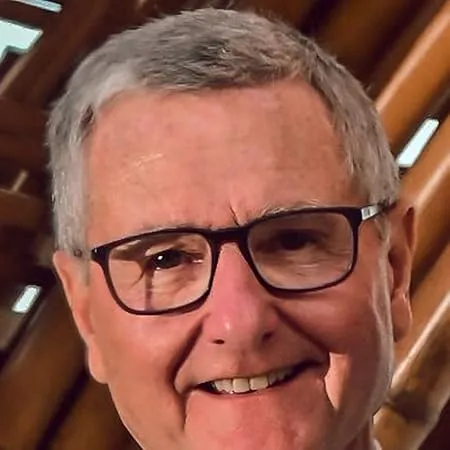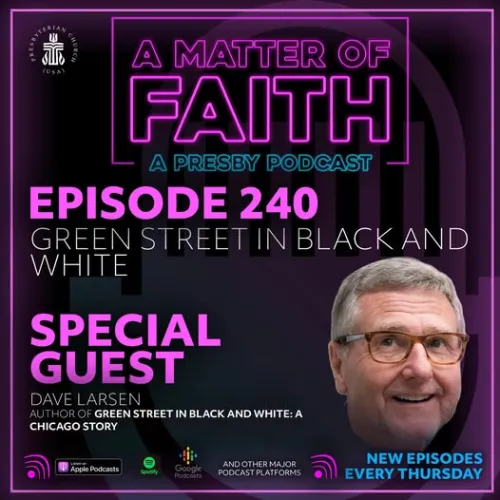Fiction can tell the truth as well as nonfiction can
Dave Larsen, the author of a book on growing up in Chicago’s South Side in the 1960s, is the guest on ‘A Matter of Faith: A Presby Podcast’

LOUISVILLE — Dave Larsen’s historical fiction book, “Green Street in Black and White: A Chicago Story,” speaks about social issues in ways nonfictional accounts can’t. Larsen, who’s retired as executive director of the Chicago-based Bright Promise Fund for Urban Christian Education, was the guest last week on “A Matter of Faith: A Presby Podcast,” hosted by Simon Doong and the Rev. Lee Catoe. Listen to their 52-minute conversation here.

Published in April, Larsen’s book follows Erik Pedersen and his friends, the Green Street Boys, who were growing up in the early 1960s in the Englewood neighborhood on Chicago’s South Side. The boys confront prejudice, discover solidarity and witness the cracks in their seemingly ordinary world. As families leave the neighborhood as part of white flight, Pederson is thrust in a moral conflict that challenges his understanding of right and wrong.
Larsen’s book includes real events from the author’s childhood on Green Street, including riding in an uncle’s Chicago police car, a church hiring a seminary intern to track where Black families were moving, and a tragic shooting.
Catoe and Doong opened their most recent episode with this question for Larsen: How do the themes and experiences that inform your book, such as reckoning with change, racism and the importance of community, relate to the justice issues of our country that we are currently facing?
“That’s a great jumping-off point,” Larsen told the hosts. “People who’ve read the book say to me this resonates with a lot of what we’re dealing with today,” including opposition to diversity, equity and inclusion; book-banning; the rewriting of history; and police justice. “I think of the fact that white flight still happens in some forms in the Chicago area,” Larsen said. “I know of some churches who have moved four, five or even six times from the South Side of Chicago to further-out suburbs and beyond that into northwest Indiana.”
“A lot of that has to do with changing neighborhoods, and Christians and others unable to learn how to live with people unlike themselves,” he said. “That’s part of the dilemma of the book for Erik Pederson,” who along with his friends “are trying to make sense out of why churches and schools are leaving the area and their parents are talking about moving when they live in the neighborhood, feel safe and don’t see anything wrong, even though all of them would say they don’t know a Black kid in the neighborhood, never met them and don’t know what this is all about.”
A Black pastor in the book speaks about parishioners who “came north for the jobs to flee persecutions and lynchings and Jim Crow laws,” Larsen said. “Those are refugees, I think. It’s the difference between nomads and refugees, and I think there are parallels today.”
While researching the book, Larsen came across church council minutes he found “quite disturbing. I recognized the names of heroes as I was growing up who made some pretty racist decisions along the way.”
Faith communities “had a lot of sway when it comes to segregation and red-lining,” Catoe said. On the podcast, “we’re not shy about talking about how faith has been used to justify a lot of this stuff.” Catoe asked Larsen how he has seen that change over the years.
One person who read the book is the author and editor of children’s books. “He told me, ‘Children’s books typically end on a hopeful note. Do you think your book ended on a hopeful note?’ I had to say, ‘I’m not sure.’”
“I intentionally left it with Erik Pederson wondering how to put this all together in his mind for his future,” Larsen said. “He and his friends loved the neighborhood … and yet his church and his family were being uprooted. Do I see any change today? I think there are hopeful signs today.”
During his years leading a nonprofit for urban Christian schools in Chicago, “it was thrilling to see those schools thrive as a multicultural, multiracial assemblage of people from churches or no church at all, working together in the same direction — all a reflection of what the kingdom of God should look like,” Larsen said.
“I think there are churches who are much different now and have learned from their mistakes” from decades ago, he said. “But it’s taken a long time.”
“We’ve also come a long way in terms of legislation,” he said, “but there’s always a threat that may not last.”
The book describes an era when Erik and his friends could bike from their neighborhood to Midway Airport to watch the planes land and take off. Or they could pedal to the Museum of Science and Industry. At the supper table, “Their parents would ask them, ‘what did you do today?’ They would tell them and the parents would say, ‘oh, that sounds interesting.’ That’s totally unheard of today,” Larsen noted.
Curiosity allows Erik “to absorb things, to listen to the Black pastor across the street and to his wife, and to hear things he’s never heard from his parents.”
The other issue for Larsen became a chicken-and-egg argument.
“Did the community move and then the institution, or is it the other way around? Is white flight institutional, individual, or both? Who takes the lead? Does the institution follow people moving, or does the institution drop enough hints that things are changing that people say, ‘we better leave now.’”

“Kids are good at asking hard questions,” Catoe said. “Times have changed, but the issues haven’t changed. This story is great because telling our stories is the only way to combat [sins, including racism].”
Then Larsen wondered, “Where does critical thinking come in a church setting? ‘Reformed and always reforming’ is a statement about curiosity. We learn from our parents, and we hopefully learn to discern when we are bombarded and flooded by stuff on the internet. I think it’s even more caustic today because of the multiplicity of sources.”
Doong said there are “growing pains to be had with this hope of there being something better on the other side” by white parents uprooting their children to move to another neighborhood.
“I wanted to make sure I addressed the grievance society that has been captured [recently] by a certain political party,” Larsen said. In his research, he was shocked to learn there used to be a Ku Klux Klan klavern within the Chicago Police Department. “There’s a theme of fear throughout the book. That’s counter-Christian. We shouldn’t be living by fear. White flight is fueled by fear of personal safety, fear of crime rates, fear of losing financial solidity because we are going to lose money on our home if we sell it, fear of the unknown.” The fear that “’I don’t know any Black people, and from what I hear, I don’t want to’ builds up in a community. Did the church follow the people [in their white flight], or did the church give validity to the move in policy ways?”

“This is my story,” Larsen said, “but it’s related to history. If we wipe out whole chapters of history in this country, we won’t be in good shape, and that’s beginning to happen.”
People who have read the book have told Larsen he’s going to “upset a lot of people with this story. I tell them, ‘that’s the point.’ We want to ask ourselves questions about what was going on then that are still going on today.”
At one point in the book, a white missionary who’s being called to Nigeria asks the congregation during worship, “Why are you calling me to Africa to talk to Black people when you can’t talk to them here?”
“Those are the dynamics I wanted to make sure were in the book,” Larsen said. “The story invites you to speculate, to look toward what the boy is looking at [on the cover] and at what he’s thinking. The cover artist did a great job.”
New editions of “A Matter of Faith: A Presby Podcast” are released every Thursday. Go here to listen to previous episodes.
You may freely reuse and distribute this article in its entirety for non-commercial purposes in any medium. Please include author attribution, photography credits, and a link to the original article. This work is licensed under a Creative Commons Attribution-NonCommercial-NoDeratives 4.0 International License.




